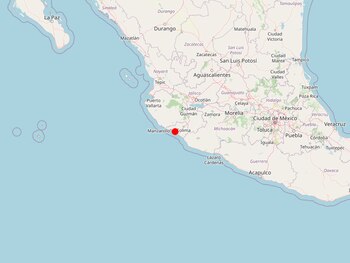
Manzanillo was the epicenter of a 3.0 magnitude earthquake that surprised the inhabitants of the state of Colima today at 3:03 in local time (9:03 UTC).
The earthquake occurred 18 km east of the city and had a depth of 53 kilometers, according to preliminary information.
are still no details about material damage or casualties in the state of Colima as a result of this telluric movement, due to the recent episode.
In the face of significant seismic activity, the National Center for Disaster Prevention (CENAPRED) calls for not falling into rumors or false news and only to report to official sources, such as the Civil Protection authorities, both local and state, as well as federal.
After an earthquake, check your home for possible damage, use your phone only in case of emergency, don't wear matches or candles until you make sure there is no gas leak and remember that there may be aftershocks of the earthquake, so it's important to stay alert.
You can also take the following steps before an earthquake: prepare a civil protection plan, organize evacuation drills, find safety zones at home, school or workplace, and prepare an emergency backpack.
During an earthquake stay calm and stay in a safe zone, stay away from objects that may fall; if you are in a car, park and stay away from buildings, trees and poles; and if you are on the coast, get away from the beach and take refuge in high areas.

Earthquakes in Mexico
Mexico is located in an area of high geological activity , which exposes it to the constant risk of earthquakes. Proof of this were the earthquakes of 1985 and 2017, which caused great damage, however, they have not been the largest in the history of the country, despite being one of the most present in the memory of both nationals and foreigners.
On March 28, 1787, a colonial Oaxaca was shaken by what has been the strongest earthquake recorded in Mexico so far. With a magnitude of 8.6, it was followed by a tsunami that went 6 kilometers beyond the coast.
Far from considering it an isolated event, the Centre for Instrumentation and Seismic Recording (Cires) considers the possibility that the country will face a similar situation in the near future. In the studies carried out in 2009 to analyze the aforementioned event, it was concluded that earthquakes of a similar magnitude may develop in the area between the coasts of Mexico and Central America. There, in the so-called Guerrero Breach, there is great geological potential to provoke catastrophes of such proportions.
However, seismic events of lower magnitudes can also cause great destruction. During 1985 and 2017, Mexicans watched with astonishment as the country's capital plunged into chaos due to two earthquakes of less intensity than in 1787.
As for 1985, it happened on September 19 of that year at 7:19 local time (13:19 UTC), with epicenter in the state of Guerrero and a magnitude of 8.2. Since then, it was believed that nothing like it would happen again, but, coincidentally, it happened again exactly 32 years later.
The 2017 event took place between the states of Puebla and Morelos at 13:14 local time (18:30 UTC). The toll of human casualties reached 369 deaths.
MORE NEWS
Últimas Noticias
Debanhi Escobar: they secured the motel where she was found lifeless in a cistern

The oldest person in the world died at the age of 119

Macabre find in CDMX: they left a body bagged and tied in a taxi
The eagles of America will face Manchester City in a duel of legends. Here are the details

Why is it good to bring dogs out to know the world when they are puppies




